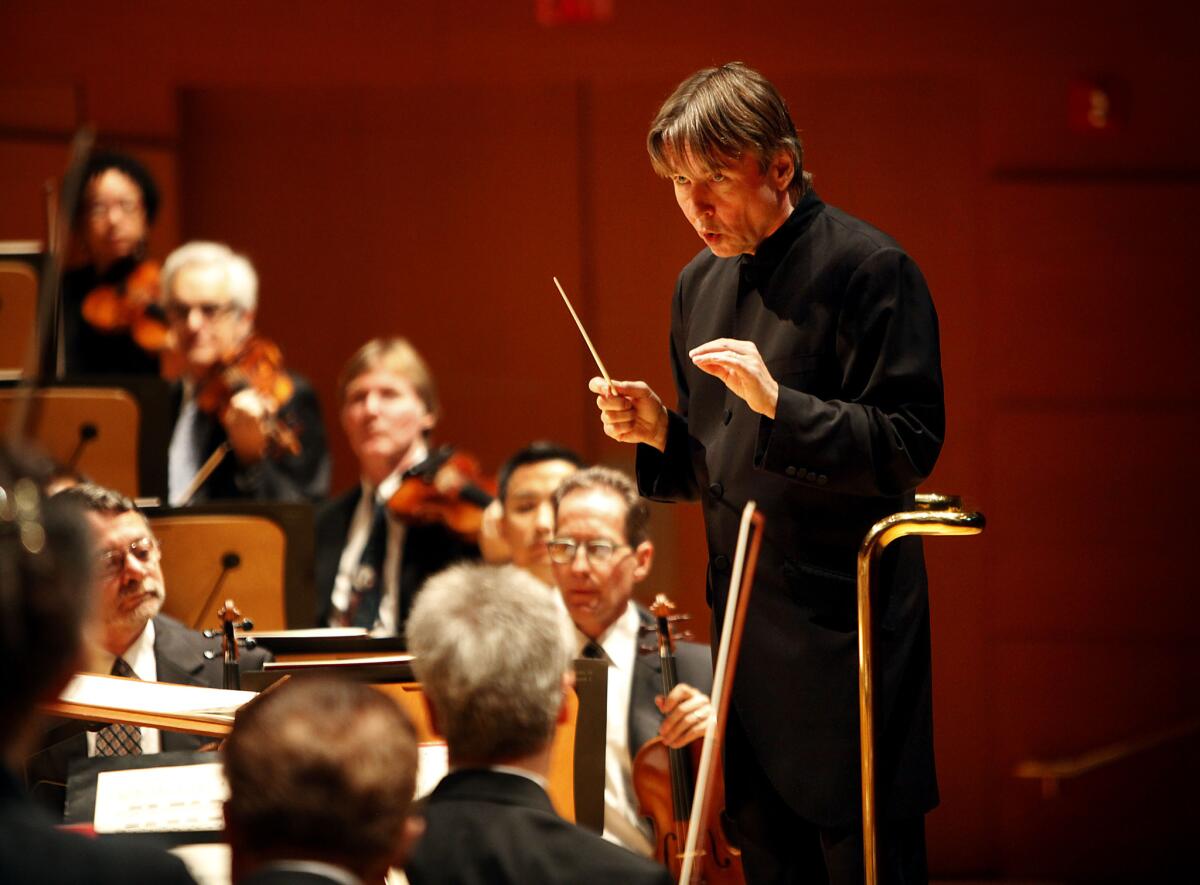A brilliant start to Esa-Pekka Salonen’s L.A. Phil residency

- Share via
Esa-Pekka Salonen returned Friday night to the Los Angeles Philharmonic for his annual fall residency with the orchestra at Walt Disney Concert Hall. This time, he really returned.
He is once more an Angeleno, having moved from London back to Santa Monica this year. Although his main gig remains as principal conductor of London’s Philharmonia Orchestra, the L.A. Phil, which Salonen led for 17 years and of which he has been conductor laureate for five, still sounds like his when he conducts it. Salonen left no doubt about his history with the orchestra in Friday’s brilliant program.
The big piece, Sibelius’ “Lemminkäinen” Suite, is a Salonen specialty. He recorded it with the L.A. Phil in 1991, the year before he became music director. He was 32. Although one of the four movements, “The Swan of Tuonela,” was a Sibelius fave, the full 45-minute score was a rarity. It is less so now, thanks in part to this exhilarating if idiosyncratic recording.
Even before that recording, Salonen had begun championing in L.A. the music of longtime Finnish friend Kaija Saariaho. He gave the U.S. premiere of her “Du Cristal” with the L.A. Phil in the Dorothy Chandler Pavilion late in 1990 and then hauled the orchestra over to Royce Hall to record it. This was the first big break for a composer who had gone from being a provincial organist in Finland in her youth to a cosmopolitan avant-garde composer with extraordinary new notions about sound and harmony.
On Friday night, Salonen gave the U.S. premiere of Saariaho’s most recent orchestral work, “Maan Varjot” (Earth Shadows), which happens to be for organ and orchestra. This may not be exactly a return on her part to her organ roots, but the electric energy she brings to the timbre of the organ as well as to the orchestra is a reminder not just of where she came from but also how far she has come.
In her program note, Saariaho quotes the opening of a verse in Shelley’s elegy for Keats from which she took her title. “The One remains, the many change and pass,” Shelley wrote in “Adonaïs.” “Heaven’s light forever shines, Earth’s shadow’s fly.”
Saariaho’s score, however, better brings to mind the lines that follow, in which life is compared to the “dome of many-colored glass” and heaven’s light to “the white radiance of Eternity.” A dome of many colors, Disney’s organ, and the hall’s resident orchestra, also shimmered with a color chart’s worth of Benjamin Moore shades of radiant white: white ice, white diamond, chalk white, ultra white, dune white, baby’s breath and all the rest.
Written for French organist Olivier Latry, he began the three-movement score (which Saariaho resists calling a concerto), with the surreal, color-free rumble of the lowest pipes at threshold-of-hearing volume. Radiance grew gradually. The organ shimmered one way. The orchestra shimmered in a different way. Shimmers combined into one and drew apart in ways you might expect only electronically produced sound to be capable.
The central movement held the most earthly colors, the grays and browns of the metallic elements and of the soil. Lush melody found a voice. But radiance again rose in the final section, a mirage of sound effects.
Sound was evidently the evening’s theme. Salonen began with Janácek’s Sinfonietta, the greatest music intended for sport. Begun as a brass fanfare for a Czechoslovakian athletic event in 1925, it grew into a small symphony with glorious brass outbursts. At Disney, a row of trumpets and tubas stood in front of the bench seats behind the stage and let rip. The deal this time was golden radiance and in just about as many shades of Saariaho’s white.
“Lemminkäinen” tied Salonen and Saariaho together in unexpected ways. It is early Sibelius, their national composer, from whom both have rebelled but to whom they have made yet another return. In 1991, Salonen’s effort was to bring out the Modernist elements in this symphonic collection of tone poems based on Finland’s national epic, the “Kalevala,” and its randy hero, Lemminkäinen.
On Friday, he let Sibelius be. The performance was fleet and sounded effortless and strange, sometimes exciting music blossoming naturally yet spectacularly. The performance was a sensation, and it’s time for a new recording.
Twitter: @markswed
More to Read
The biggest entertainment stories
Get our big stories about Hollywood, film, television, music, arts, culture and more right in your inbox as soon as they publish.
You may occasionally receive promotional content from the Los Angeles Times.











